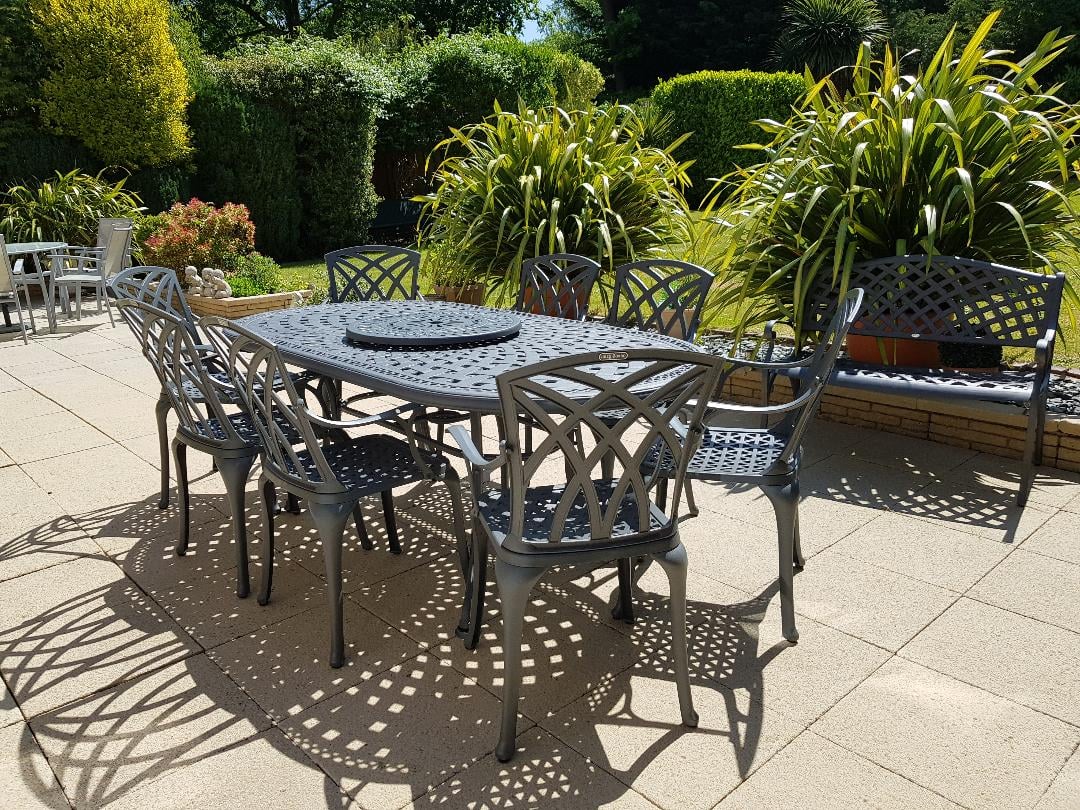You will see a lot written about the pros and cons of different outdoor furniture materials on this blog and others in our sector. One person's advantage, such as say weight, could even be another's disadvantage, so it pays to do a little research to establish what’s best for you and your outdoor space.
The key is to pick the right style, type, size and material for your garden and how you like to spend time in it. We recently looked step-by-step at the full decision-making process in our How to shop for outdoor furniture sets buyer's guide.
If you were to ask people what they think is the biggest disadvantage of metal patio furniture, the ‘R’ word would most definitely be top of the list. One of the most common questions we get asked when it comes to metal outdoor furniture is whether it will rust.
However, we need to insert a big but here… Yes, metal patio furniture can rust, but the extent or potential for rusted metal very much depends on the type of metal used and the protective measures applied to the metal to make it fit for outdoor use.
The same is true with wooden furniture. It can rot but not all woods are created equal. Teak, for example, will offer infinitely better natural protection than a lower-grade pine or cedar. Different metals have very different characteristics and will require different levels of maintenance to keep them protected from the elements.
Anything that sits outside, be it a car or furniture, will weather in time. For us, the materials that are fit for purpose are the ones that will last the longest outside without rotting, warping, fading, splitting or rusting, with the least amount of maintenance to keep them that way, such as painting, staining, etc.
In this article, we want to take a closer look at the different metals that are popular in UK gardens, analyse their susceptibility to rust, explore how to prevent it, and explain why we think metal outdoor furniture is the best material for the UK climate.
What are the different types of metal outdoor furniture?
The 5 most popular types of metal used in the UK garden furniture industry are Cast Iron, Wrought Iron, Steel, Stainless Steel, and the core material in our range, Cast Aluminium. We will now look at each of these materials in detail.
1. Cast Iron Furniture
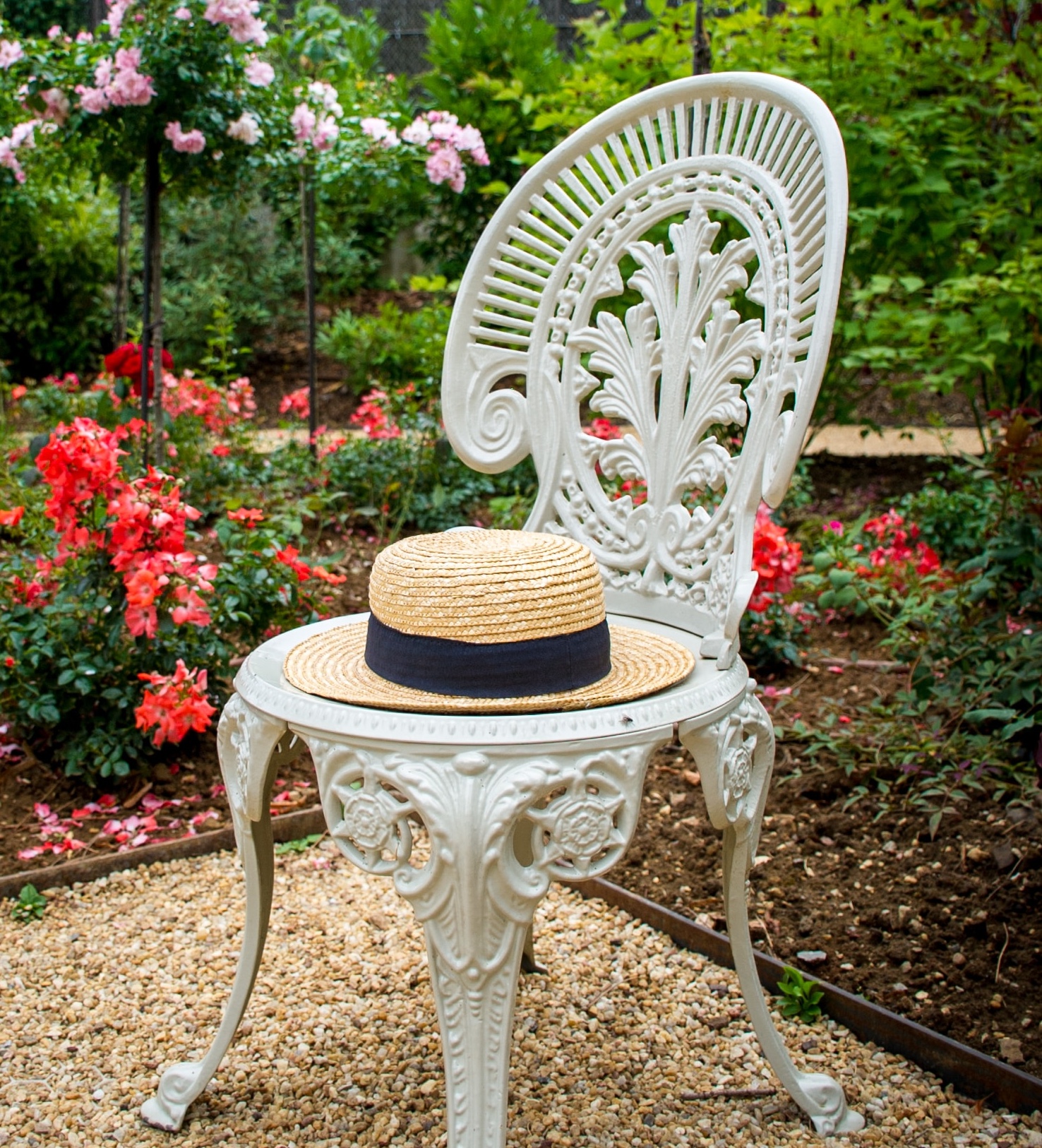
Cast iron is a group of iron-carbon alloys with a carbon content greater than 2%. The name is derived from its characteristic casting process, whereby molten iron is poured into a mould and allowed to solidify. The high carbon content makes cast iron hard but it can be brittle compared to other metals.
Cast iron garden furniture is known for its classic and timeless style, and it often features intricate designs and detailing. Pieces are heavy and durable but they will require regular maintenance such as painting to prevent them from rusting.
When fully protected it is sturdy and has the ability to withstand all weather conditions. Regular cleaning, a yearly application of a speciality rust-resistant metal paint, and storing the furniture indoors during harsh weather conditions will help to preserve its appearance and functionality.
2. Wrought Iron Furniture
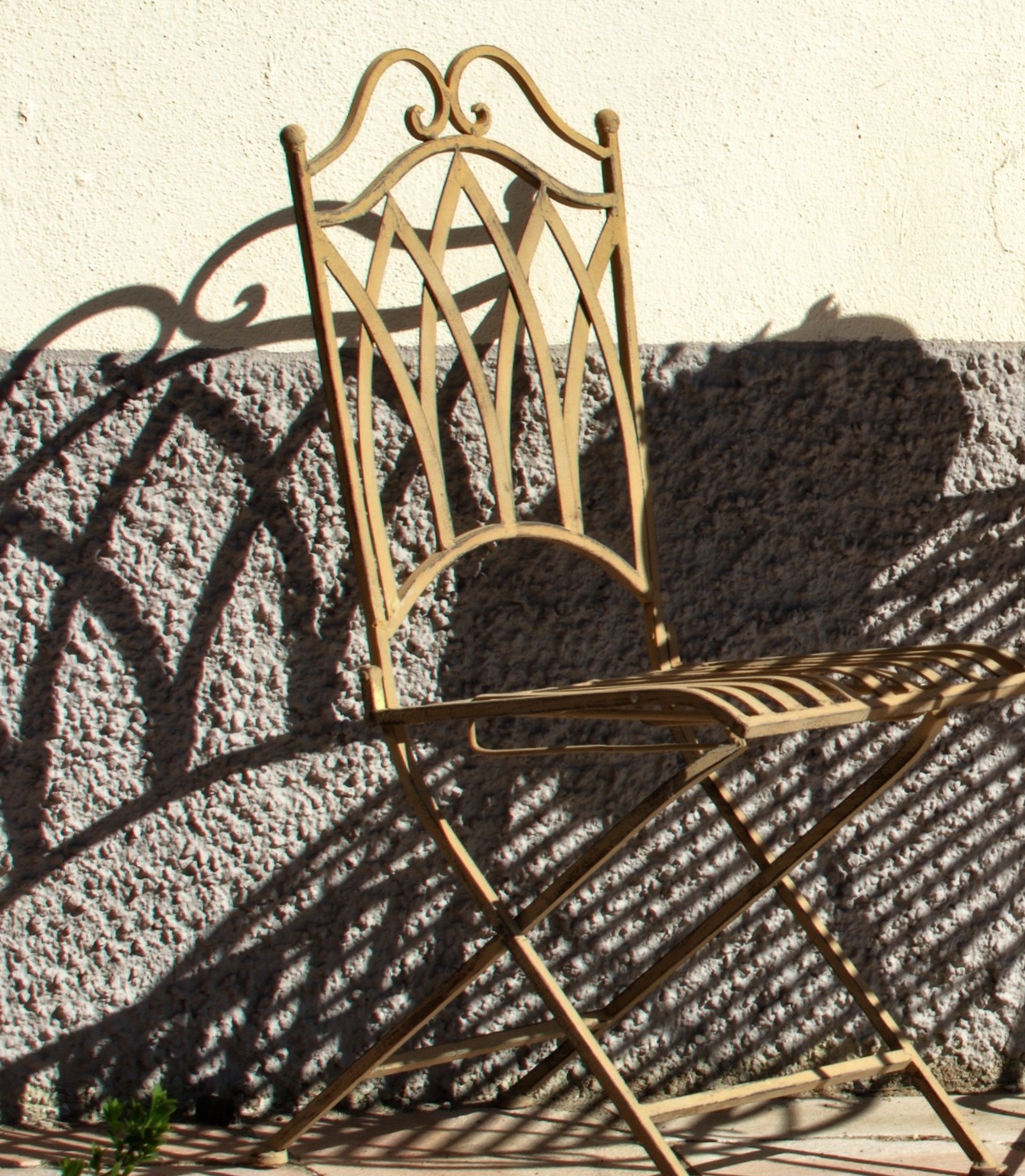
Wrought iron on the other hand has a very low carbon content in contrast to cast iron. The term "wrought" simply means to work, and wrought iron is so named because it is forged and worked by skilled blacksmiths.
It has a fibre-like structure due to the process of forging and working the iron, which involves repeatedly heating and hammering it to remove impurities and shape it into various forms. The fact it is handcrafted is one of the reasons this material has endured but for that reason, it is the most expensive metal on our list.
Known for its timeless, elegant and intricate designs, it is the heaviest of metals and, whilst durable, it too will require regular maintenance to prevent rust. The fact it is highly susceptible to rust, and that can be an issue, especially if you live on the coast.
However, much of the wrought iron outdoor furniture sold in the UK is coated with a painted or powder-coated finish to help protect it from oxygen and moisture exposure. Periodic maintenance, such as regular cleaning and repainting, is also recommended to prevent rust.
3. Steel Patio Furniture
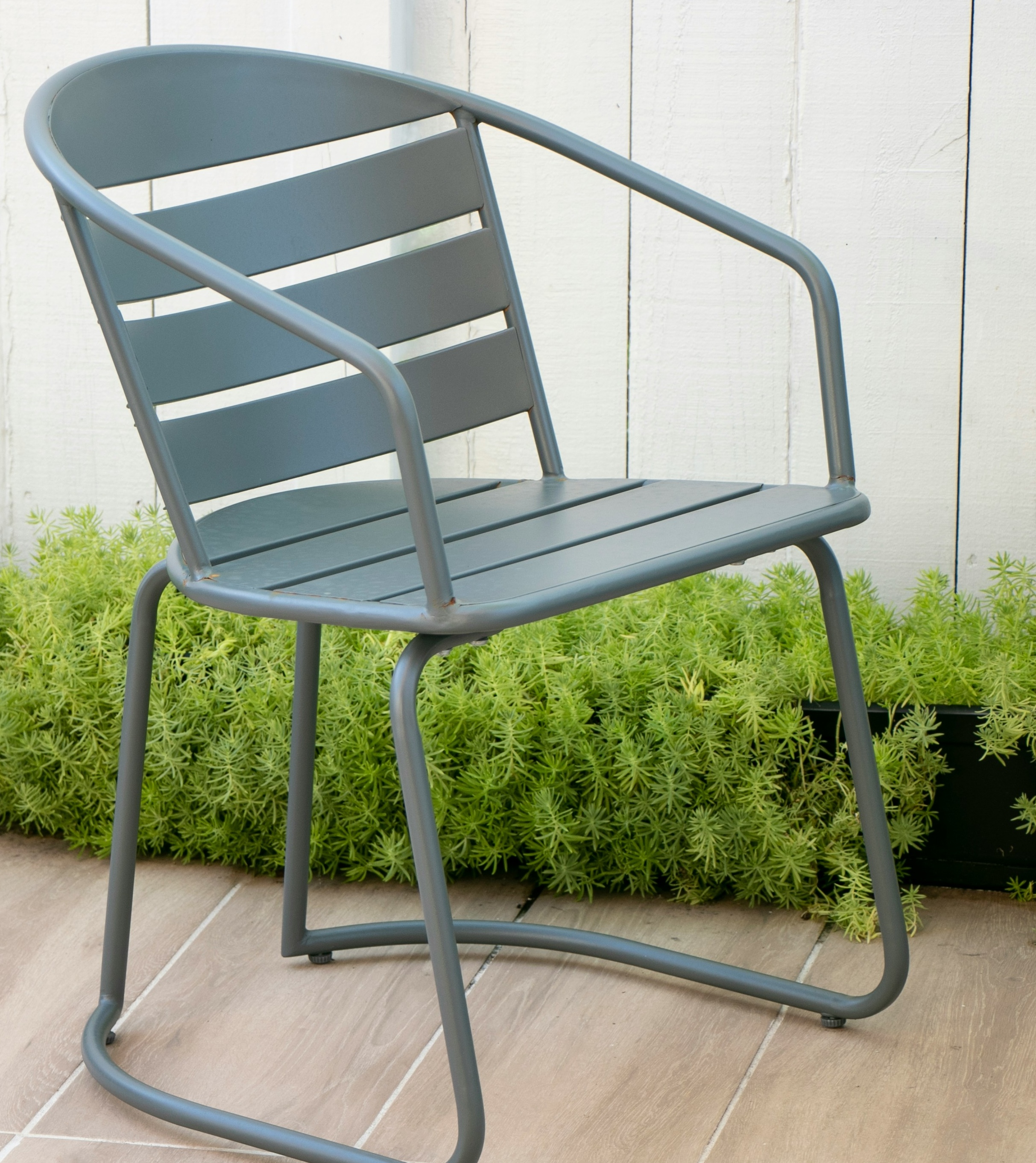
Steel is an alloy of iron and carbon, whereby the carbon content is typically between 0.2% and 2.1% by weight. In addition to iron and carbon, steel may also contain small amounts of other elements, such as manganese, silicon, sulphur, or phosphorus. The presence of these elements and the specific manufacturing process is what will contribute to the properties of different types of steel.
Steel outdoor furniture is sturdy, and durable, and is often found in more contemporary styles and designs. Due to the iron content, regular steel is also highly prone to rusting when exposed to moisture and oxygen.
To prevent rust, much of the outdoor steel furniture on sale in the UK is also treated with a protective coating, such as powder coating or galvanisation. That said, regular maintenance, such as applying a rust-resistant sealant or paint, is recommended to help protect and prolong.
4. Stainless Steel Furniture
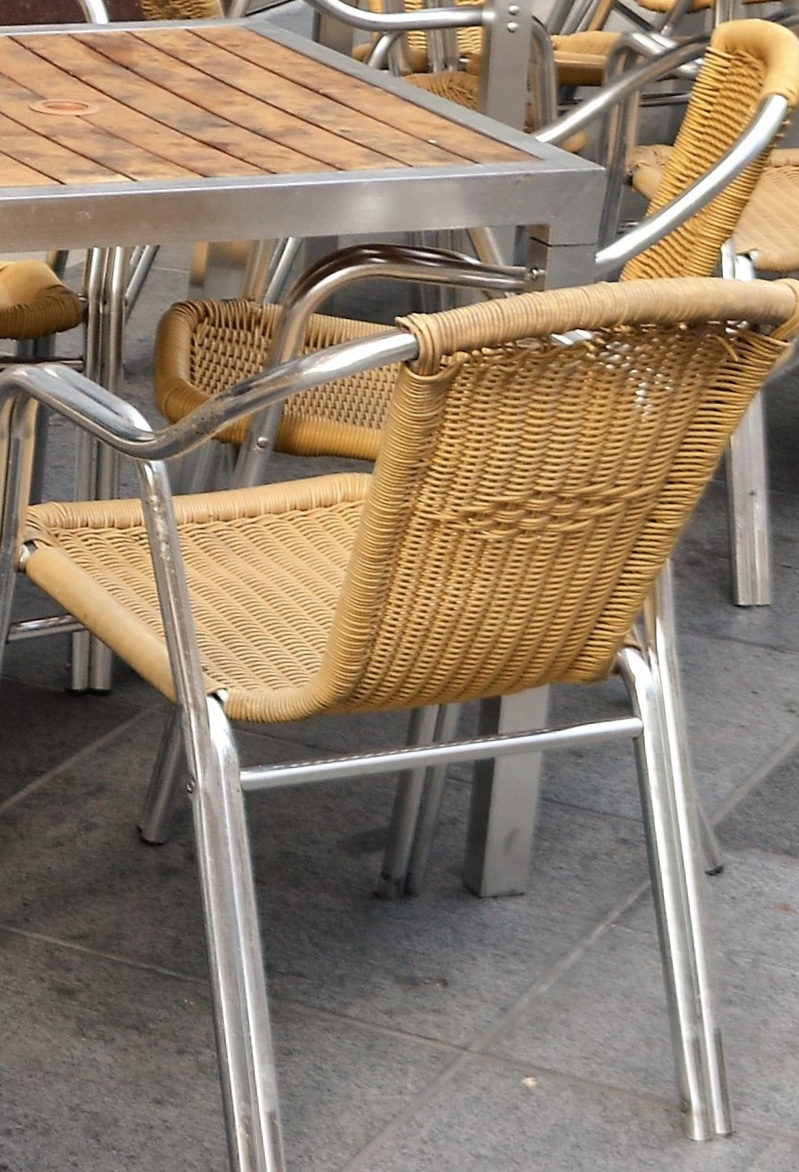
Stainless steel is different to regular steel in that it contains a minimum of 10.5% chromium by mass. The addition of chromium forms a thin, invisible layer of chromium oxide on the surface of the steel, which is what gives stainless steel its corrosion-resistant properties.
In addition to chromium, stainless steel patio furniture will often contain other alloying elements such as nickel, molybdenum, titanium, and manganese, depending on the specific grade. The flip side of this is that its greater durability and corrosion resistance make it a more premium-priced option.
Stainless steel is more difficult to work with, which is why it is often found on more furniture with a more minimal, modern and sleek look. However, many find the long-term durability and aesthetic appeal of stainless steel to be worth the investment.
5. Cast Aluminium Patio Furniture
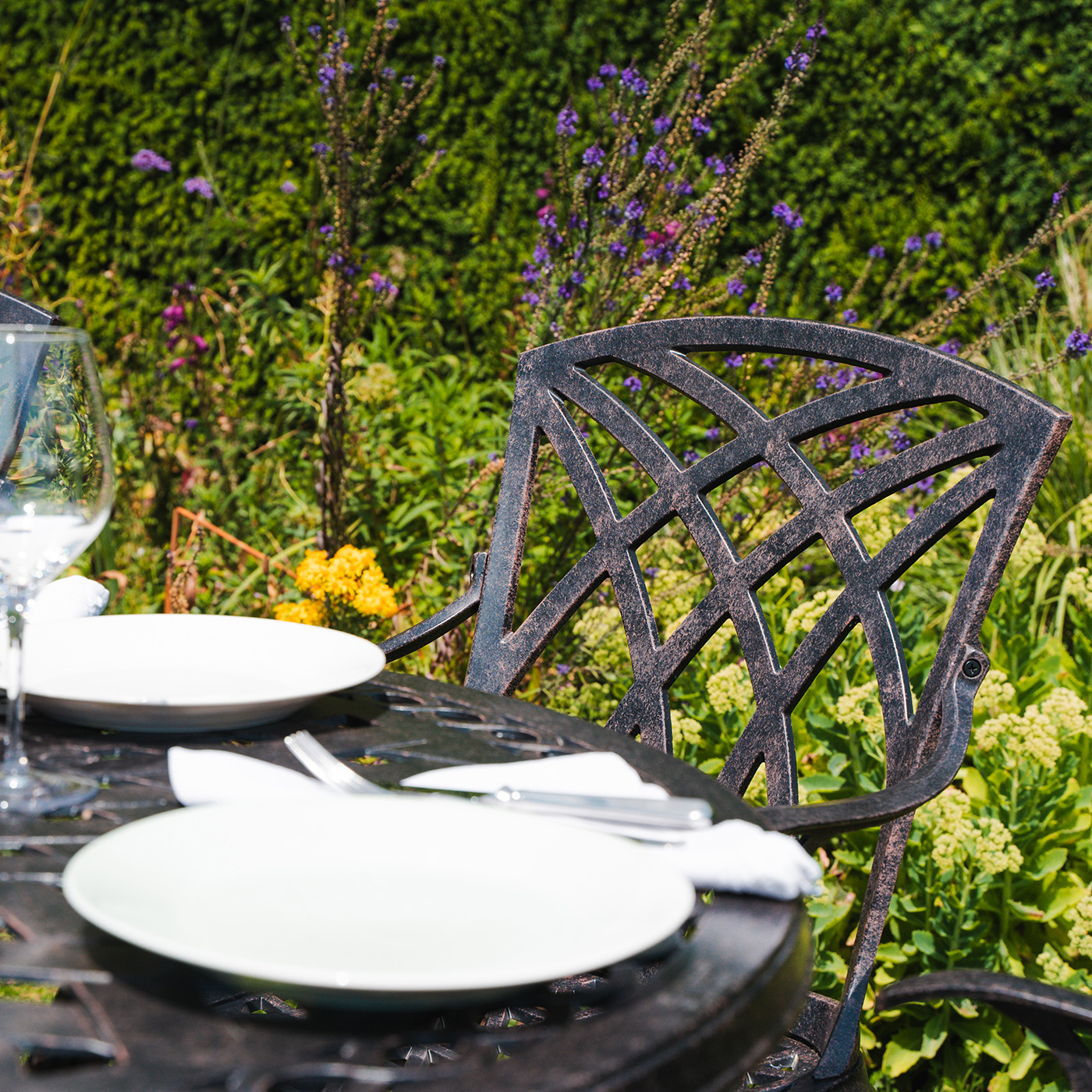
Cast aluminium or aluminum as they call it in the USA refers to alloys that are also formed using the aforementioned casting process, however, this time molten aluminium is poured into a mould and allowed to solidify to the desired shape.
Aluminium casting can be achieved through various methods, including sand casting (the method we predominantly use), die casting, and investment casting. The choice of casting method depends on factors such as the complexity of the part, the desired surface finish, and the volume of production.
Aluminium is a naturally corrosion-resistant metal and even when raw (i.e. not coated) it does not rust like steel or iron. That said, it can still corrode, whereby a thin, protective layer will form on the surface of raw aluminium when it is exposed to oxygen in the air.
This layer actually protects the metal and helps prevent further corrosion. It is pretty unsightly though, so we further protect it by applying a durable painted finish that not only looks great, it prevents it from oxidising and pitting.
Cast Aluminium is the perfect metal patio furniture for our climate, and after much testing and research, we found it a great all-rounder that helped us create a timeless collection, which best fits with how we like to use our outdoor spaces.
How do you protect metal patio furniture and prevent rust?
Protecting metal furniture and preventing rust involves a combination of proactive measures and regular maintenance. Here are some tips to help you keep your metal furniture in good condition:
1. Choose Rust-Resistant Metals
When purchasing metal outdoor furniture, make sure you know what you are buying. Opt for materials that are less prone to rust and corrosion such as stainless steel and cast aluminium or those with a durable protective finish/coating.
These metals are much more resistant to a variety of environmental factors such as moisture, salt, and UV rays. This resistance makes them suitable for even coastal areas where salt air can greatly accelerate corrosion.
Rust-resistant metals or those coated with a protected finish will also have a longer lifespan compared to metals that are more susceptible. They will require significantly less maintenance to keep them that way too.
Whilst these metals might have an initially higher upfront cost, they will provide better value for money in the long run. The extended lifespan and lower maintenance requirements will offset the initial investment over time.
The metal we use here at Lazy Susan for our collection is a high-grade sand cast aluminium and as we stated in our How is cast aluminium garden furniture made? article:
“The high-tensile cast aluminium we use in the construction of our garden furniture range gives us furniture that is not only beautifully crafted, but it is also low maintenance and perfectly suited to wind, rain, snow and sun. It will not split, warp, fade, rust, or rot and can be left outside uncovered if you wish. We have created a range of dining table-style sets that not only look great on your patio but are designed for family use. Combining cast aluminium with a powder-coated protective finish produces beautiful yet highly durable furniture that has many benefits over other materials such as steel, iron, rattan, wood and plastic.”
2. Regular Cleaning
We often use the adage that prevention is better than the cure when it comes to outdoor furniture. Cleaning your furniture regularly to remove dirt, debris, and salt, is essential in maintaining metal surfaces, protecting the finish, and preventing corrosion.
Use a washing-up liquid or car shampoo and warm water to clean and avoid any abrasive cleaning products or solutions that can damage the protective coating. Regular cleaning will remove dirt, dust, bird droppings, tree sap, and other debris that can accumulate on the surface that can trap moisture and contribute to the development of rust.
If your metal patio furniture has a protective coating, such as paint, clear sealant, or powder coating, regular cleaning will help to maintain the integrity of the finish. A well-maintained coating acts as a barrier against moisture and oxygen, the primary factors that lead to corrosion.
If you have our furniture, and you find a stone chip or scratch, then it is an easy fix with our metal primer Touch-Up Kits. The video above shows you how to apply and our How to touch up paint chips and scratches on metal garden furniturearticle has a comprehensive step-by-step guide.
3. Apply a Protective Coating
Leave anything outside for a period of time and, regardless of the material, it will weather. Metal is tough stuff but a little extra protection is always a good idea.
If it hasn’t got one already, then you can apply a protective coating to the surface to create a barrier against moisture and oxygen, which are the main contributors to rust. Common coatings include outdoor metal paints and enamels, or you could apply a clear sealant if you do not want to alter the appearance.
Another popular solution, if the metal is already painted or coated is to apply a light oil-based coating, such as linseed or mineral oil, to create an additional protective layer. For our cast aluminium range, we recommend a light coat of car waxas this will help to repel rainwater, is dry to the touch once buffed, and will give the painted surface a nice lustre.
4. Remove Rust Immediately
If you do notice any signs of rust or corrosion forming on your metal patio furniture, then address it immediately. You can use a wire brush or fine-grit sandpaper to gently remove the rust, and then apply a rust-inhibiting primer to the affected area and refinish to match the finish.
Keep in mind that prevention is key to maintaining the longevity of your metal patio furniture. Consider applying a protective coating as mentioned earlier to minimise the risk of rust formation in the future.
If rust does appear, then address it promptly to prevent further deterioration of the metal, and if you can’t do that speak to a specialist to see if it can be repaired for a reasonable fee or if it would be better replaced.
5. Use Outdoor Furniture Covers
Moisture is a primary catalyst for rust formation, so it pays to keep your metal furniture dry if you’re concerned. Outdoor furniture covers during periods of non-use or during the winter months if you don’t have an indoor place to store is the best solution.
It will help to protect your investment and extend the lifespan of your furniture, but most importantly just help to keep it clean and ready to use.
What is important though, is that they are designed for outdoor use and to fit your specific furniture pieces properly. Ensure that the covers are fully waterproof but breathable to prevent condensation, which could lead to mould and mildew.
Additionally, get individual covers for each piece (tables, chairs, etc) that are fitted with secure ties or straps to prevent them from being blown off in windy conditions. There are a number of companies online that will make bespoke covers to fit the shape and size of your furniture.
6. Touch Up Chips & Scratches Immediately
As already mentioned, scratches or chips in the painted finish could potentially compromise the protective coating on metal furniture, making it more susceptible to corrosion and rust.
Be cautious when moving or using metal items around with our outdoor tables and chairs, always make sure you fit the screw-in plastic feet to protect the metal and your patio surface.
This is something we looked at in detail in our What type of furniture is best for your patio surface? post, while our aforementioned How to touch up paint chips and scratches on metal garden furniture article and the video (above) will show you how to touch up our metal furniture.
6. Use Rust Inhibitors
We would not recommend this for our range, it is not needed, however, with some metal furniture, there is the option to apply a rust inhibitor or rust-resistant spray to provide an additional layer of protection.
These products contain chemicals that help prevent or slow down the formation of rust. However, we would only recommend you do this if you know what you are doing. Otherwise, seek out a professional.
Different rust inhibitors have various application methods, so always follow the specific instructions provided by the product manufacturer. Additionally, periodic inspections and reapplication will often be required to maintain its effectiveness over time.
7. Store Inside During Winter
We touched on this in the covers section but, if possible, store metal furniture in a shed or garage during severe weather conditions, such as heavy wind, rain or snow. This will help to protect the furniture from some of the extreme weather that seems to be more frequent in the UK.
Storing metal garden furniture inside during the winter is a good practice for several reasons, and it can help prolong the lifespan and maintain the appearance of your furniture. We looked at this in detail in How to safely store our metal garden furniture in a shed or garage for winter.
Metal, especially iron and steel, is susceptible to rust when exposed to moisture and cold temperatures. Storing your metal garden furniture indoors during the winter will help prevent the accumulation of snow and rain, reducing the risk of rust forming.
When storing metal garden furniture indoors for the winter, make sure the storage space is dry and well-ventilated. Clean the furniture before storing it to remove any dirt or debris, and consider using covers for added protection.
8. Regularly Inspect Outdoor Tables & Chairs
This is another point we touched on earlier but it is vital with all types of outdoor furniture that we regularly inspect it to identify and address any potential issues before they become more serious.
This will help you catch any potential problems early and extend the lifespan of your furniture. Any chips or scratches should be touched up, any bird dropping or sap can be removed, and any loose bolts can be retightened.
By following these preventive measures and incorporating regular maintenance and cleaning into your garden routine, you can significantly reduce the risk of rusted patio furniture and keep your outdoor metal furniture looking good for longer.
3-year guarantee on our metal patio furniture
If you identify any issues with our cast aluminium, in the first instance, please contact our customer service team. Our commitment to quality ensures that all our products are designed and manufactured using the highest quality materials and production techniques.
To underline the confidence we have in the quality of our furniture, we offer a 3-Year Structural Guarantee on our furniture. If need be, during that time your products will be repaired or have parts replaced at the discretion of the Company free of charge.
This covers faults in materials and workmanship. Parts only will be replaced provided that our common terms listed below have been adhered to. You will find full terms and conditions for our 3-Year Guarantee here.
If you have any photos of our metal outdoor furniture in your garden, then we’d love to see a few for our Do Some Good charity campaign. You can tag us @LazySusanFurniture on Instagram or Facebook or Upload Here.




